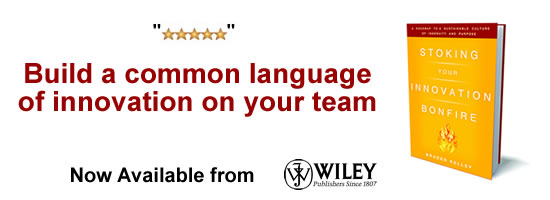Is innovation really important to you?
 How can we establish Innovation as the vital link to a process of change and strategic direction options? One that lifts the debates of managing today’s business by linking it into the future and then turning this thinking into a series of plausible and coherent set of activities?
How can we establish Innovation as the vital link to a process of change and strategic direction options? One that lifts the debates of managing today’s business by linking it into the future and then turning this thinking into a series of plausible and coherent set of activities?
Innovation can drive change, change is required. Without innovation, we progressively die, as we provide no option for change, no prospects of new, different growth. So why does it continually fail to happen?
We innovators certainly need a new model of change, for at least eight important reasons I can think of, that render what we have practiced in the past as obsolete:
1. As innovators we aren’t simply responding to external change, we are creating change, both for customers and for our companies and markets. (the inside, proactive change vs external, reactive impact). The ‘flood’ of data, of customer dialogues, is offering us ‘signals’ to explore and seize opportunities by being agile, aware and alert to the new discovery of needs not being fulfilled.
2. External change is far more unpredictable, in global markets new threats emerge from anywhere, at any time and often delivered in totally unexpected ways, through new business models that totally cut through and disrupt the existing positions. They can render the existing obsolete in seemingly rapid time, irrespective of the efforts to respond as they have discovered the unmet need to deliver solutions to it.
3. The pace and nature of change is not slowing down but accelerating and will continue to accelerate at increasing pace, frequency and amplitude of change. Organizations need to pick up the pace, learn to accept a greater risk, experimentation and rapid adjustment of the new knowledge flowing in to build the final outcome to the needs of the market and customer.
4. Sudden rapidly evolving markets make everything needing to be ‘super’ responsive by existing players, to the sudden realization they have missed opportunities, Many existing organizations cannot cope and alter with this demand for agility, flexibility, and responsiveness. They need to (re)learn this and build it into their systems and often this realization comes too late, they have fossilized.
5. As often demonstrated, most innovation has the potential to be business model innovation, which will require change. As more innovation becomes focused on business model innovation, this will create even more change and challenges.
6. We recognize that change is no longer an occasional threat but a constant companion, so we need to shift from the idea of change as a potential inhibitor into one of developing an ongoing change capacity as part of our unique competitive advantage, evolving and pushing boundaries.
7. The idea that companies can achieve a protected steady state where change won’t affect them doesn’t seem to apply anymore, as long periods of stasis, or standing still, is no longer possible, we must be able to learn to evolve constantly and reflect that more ‘dynamic’ condition.
8. We need to think of change as a capability that we constantly deploy, rather than a threat we typically avoid and fail to understand. We need to develop change as a capability, to build skills, reduce barriers, to extend our capacity and competencies through experimentation and discovery. We need to push out of our comfort zone constantly.
Are we asking ourselves do we recognize our need to change?
How can we focus the energy around the boardroom table on to this linking the future work to the shape and the organization’s needs, making the growing innovation debate as strategic as it can be? One where change becomes a constant, delivered through innovation.
How are we going to design our innovation capabilities, competencies or capacity unless we fully recognize the dramatic changes in business that are now underway and what this needs to be addressed, to allow for a more responsive, fluid, agile and adaptive culture, to flourish and respond so as to generate the better innovation of the future we need.
Recognizing differences
There are different traits, actions and activities to think through. Here are some of the needs:
* We need to build far more serendipity into what we do, also random connections, as well as purposeful discovery, by seeking out increasing connections and engaging in networks of learning and mutual exchange.
* We need ‘safe’ places where we are turning curiosity into reality and building our innovation mental abilities for growth, development, and accomplishment, opening up and having others being receptive and then jointly translating this into new innovation.
* We need to embed into our new innovation core new routines and thinking. It is determining the changes needed by those new combinations of fusion by seeking out the chemistry from all the connections and exchanges, pushing for creative collisions, positive tensions and dynamics to engage fully in innovation, so the culture, climate, and environment are vibrant, challenging and exciting.
* We need to constantly seek the new space from knowledge exploitation and exploration, redefining the organization edges, enlarging and enhancing our understanding.
* We need pushing constantly out, constantly evaluating, discovering and aligning growth options and then seeking out those outcomes that potentially offer the right return on innovation
* We need to place learning into the center, to allow our capability building, new competencies to grow and evolve.
* We need to focus on the constant wish to improve, so as to improve performance and capacities by focusing on both our mental and physical abilities to develop our position and function, to explore, expand and exploit. Each contributes to our ability to receive, hold and absorb new knowledge. We measure these by the increased volume and quality outcomes, others provide back to us.
* We need new structures, attitudes, investment and motivation to change, to focus on innovation building that needs being instilled, drive with a dedicated focus from the top, not just as a commitment that must happen but integrated and aligned with the strategic thinking and planning, worked through a clear pathway of change to achieve a different, core innovation capability.
* We need to determine the abilities to deliver in very effective, focused, efficient and aligned ways. Knowing what is important, seeking out the actions to support and deliver the part needed to achieve the desired goals. Adjusting as we go, as we learn, ramping up what is working, dampening down what is clearly not.
* We need to build innovation by working it continuously. On making our environment into this more evolving, fluid and dynamic one, where the climate and culture of innovation thrive and grows from this constant feeding and attention.
Our innovation problem that never seems to change
Innovation requires increasing agility, flexibility and allowing creativity to flourish on a constant, evolving basis. Today, innovation often stays outside the mainstream system and operational structures, most often to the organization’s detriment, as we simply accept innovation work as something that does not fit the ‘norm’.
Innovation needs to be fluid, open, responsive, adaptive; sometimes reliant on the instinct, hunch or powerful insight that is never ‘predictable’ but suddenly emerges from a collision of events, or random thoughts that lead to a new insight, a game-changing one.
Of course, it is really hard to turn this ‘randomness’ or serendipity found in innovation into a system but it is certainly not impossible. The few who recognize the ‘power’ of innovation continually show in their capacities to innovate, that they recognize that they have real growth by understanding a need and innovation, however hard, delivers on this, once identified.
This is today’s innovation problem, tackling the differences in managing innovation, so often we can’t bring innovation into the very core, it actually feeds the core but why is it that it just never seems to become the ‘beating heart’, for many? It seems too hard and disturbs the “business as usual†needs until eventually, this approach implodes, the company gets wiped from existence, lost in a wistful world of “if only.â€
Wait! Before you go…
Choose how you want the latest innovation content delivered to you:
- Daily — RSS Feed — Email — Twitter — Facebook — Linkedin Today
- Weekly — Email Newsletter — Free Magazine — Linkedin Group
 Paul Hobcraft runs Agility Innovation, an advisory business that stimulates sound innovation practice, researches topics that relate to innovation for the future, as well as aligning innovation to organizations core capabilities. Follow @paul4innovating
Paul Hobcraft runs Agility Innovation, an advisory business that stimulates sound innovation practice, researches topics that relate to innovation for the future, as well as aligning innovation to organizations core capabilities. Follow @paul4innovating
NEVER MISS ANOTHER NEWSLETTER!
LATEST BLOGS
Changing Relationship Between Electric Vehicles and Power Grid
Recently Ford announced an electric truck for the masses, the Ford F-150 Lightning, with up to 300 miles of range…
Read MoreFour Traits Your Next CEO Must Have For Your Organization to Thrive
CEOs come and CEOs go. Some – like Steve Jobs at Apple, Jeff Bezos at Amazon, and Richard Branson at…
Read More



